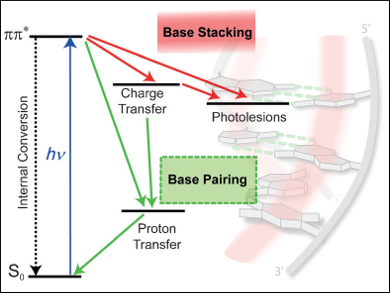What happens to double-stranded DNA when it is exposed to light? Photochemical reactions may occur that can result in mutations, but the exact process that occurs in natural DNA, which is in fact extremely photostable, is not known. Long-lived excited states that occur as a result of π-stacking have been observed in single strands, however, no studies had been carried out on natural double-stranded DNA.
Wolfgang Zinth, Thomas Carell, and their teams, Ludwig-Maximilians-University, Munich, Germany, set out to examine the role of Watson-Crick hydrogen bonding on the photoexcitation behavior of natural DNA by using UV excitation and time-resolved IR spectroscopy.
The results they obtained showed that the bases which are connected through hydrogen bonding had similar decay processes, and the lifetimes of A and T were longer than those of G and C. This result implied that base pairing was controlling excited state lifetime rather than base stacking. The researchers concluded that an ultrafast proton transfer operates, which may deactivate the charge-transfer states that arise from base stacking and are responsible for DNA damage.
- Watson-Crick Base Pairing Controls Excited-State Decay in Natural DNA,
Dominik B. Bucher, Alexander Schlueter, Thomas Carell, Wolfgang Zinth,
Angew. Chem. Int. Ed. 2014.
DOI: 10.1002/anie.201406286




